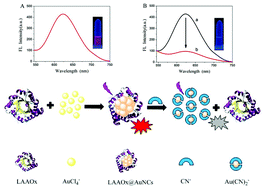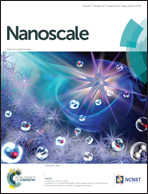Highly selective and sensitive nanoprobes for cyanide based on gold nanoclusters with red fluorescence emission
Abstract
We report a novel and environmentally friendly fluorescent probe for detecting the cyanide ion (CN−) using L-amino acid oxidase (LAAOx)-protected Au nanoclusters (LAAOx@AuNCs) with red emission. The fluorescence-based sensing behaviour of LAAOx@AuNCs towards anions was investigated in buffered aqueous media. Among the anions studied, CN− was found to effectively quench the fluorescence emission of AuNCs based on CN− induced Au core decomposition. Excellent sensitivity and selectivity toward the detection of CN− in aqueous solution were observed. The CN− detection limit was determined to be approximately 180 nM, which is 15 times lower than the maximum level (2700 nM) of CN− in drinking water permitted by the World Health Organization (WHO). A linear relationship between the fluorescence intensity and CN− concentration was observed in two ranges of CN− concentration, including 3.2 × 10−6 to 3.4 × 10−5 mol L−1 and 3.81 × 10−5 to 1.04 × 10−4 mol L−1. The high sensitivity and selectivity to CN− among the 17 types of anions make the AuNCs good candidates for use in fluorescent nanoprobes of CN−.


 Please wait while we load your content...
Please wait while we load your content...